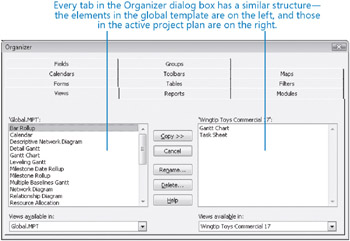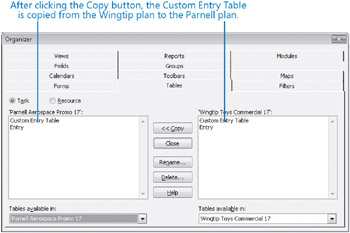Sharing Custom Views and Other Elements Between Project Plans
The Organizer is the feature you use to share customized elements, such as views, among project plans. The complete list of elements that you can copy between project plans with the Organizer is indicated by the names of the tabs in the Organizer dialog box, which you will see shortly.
One Project feature that you can work with through the Organizer is the global template, named Global.mpt. The global template is installed as part of Project and provides the default views, tables, and other elements in Project. The list of elements provided by the global template includes the following:
-
Calendars
-
Filters
-
Forms
-
Groups
-
Maps (import/export)
-
Reports
-
Tables
-
Menus and toolbars
-
Modules (VBA macros)
-
Views
| Tip | This tip describes enterprise project management (EPM) functionality. Project Standard always uses the global template. Project Professional, when used with Project Server, has a different configuration. When Project Professional is connected to Project Server, it uses the global template but is supplemented with details from the enterprise global template as well. For more information about Project Server, see Part 4, “Introducing Project Server.” |
Initially, the specific definitions of all views, tables, and similar elements are contained in the global template. For example, the fact that the default usage table contains one set of fields and not others is determined by the global template. The very first time you display a view, table, or similar element in a project plan, it is automatically copied from the global template to that project plan. Thereafter, the element resides in the project plan. Any subsequent customization of that element in the project plan (for example, changing the fields displayed in a table) applies to only that one project plan and does not affect the global template. The exception to this is macros, toolbars, and import/export maps. By default, Project stores these elements in the global template rather than in the active project plan.
You could use Project extensively and never need to touch the global template. However, when you do work with the global template, you do so through the Organizer. Some results that you can accomplish relating to the global template include:
-
Create a customized element, such as a custom view, and make it available in all project plans you work with by copying the custom view into the global template.
-
Replace a customized element, such as a view or table, in a project plan by copying the original, unmodified element from the global template to the project plan in which you’ve customized the same element.
-
Copy one customized element, such as a custom view, from one project plan to another.
The settings in the global template apply to all project plans you work with in Project. Because we don’t want to alter the global template you use, in this exercise we’ll focus on copying customized elements between two project plans. Keep in mind, though, that the general process of using the Organizer shown here is the same whether you are working with the global template and a project plan or two project plans. In fact, any custom element that you copy into the global template becomes available in all of the project plans you use.
| Important | In the Organizer, when you attempt to copy a view, table, or other element from a project plan to the global template, Project alerts you as to whether you will overwrite that same element in the global template. If you choose to overwrite it, that customized element (such as a customized view) will be available in all new project plans and any other project plans that do not already contain that element. If you choose to rename the customized element, it becomes available in all project plans but does not affect the existing elements already stored in the global template. It’s generally a good idea to give your customized elements unique names, such as Custom Gantt Chart, so that you can keep the original element intact. |
In this exercise, you will copy a custom table from one project plan to another.
| Important | If you are running Project Professional, you may need to make a one-time adjustment to use the My Computer account and to work offline. This ensures that the practice files you work with in this chapter do not affect your Project Server data. For more information, see “Starting Project Professional” on page XX. |
Open Parnell Aerospace Promo 17a and Wingtip Toys Commercial 17b from the Documents\Microsoft Press\Project 2007 SBS\Chapter 17 Customizing folder. You can also access the practice files for this book by clicking Start, All Programs, Microsoft Press, Project 2007 Step by Step and then selecting the chapter folder of the file you want to open.
1. On the File menu, click Save As.
The Save As dialog box appears.
2. In the File name box, type Wingtip Toys Commercial 17, and then click Save.
3. Repeat steps 1 and 2 to save Parnell Aerospace Promo 17a as Parnell Aerospace Promo 17.
4. On the Window menu, click Wingtip Toys Commercial 17.
The Wingtip Toys Commercial 17 project plan contains a custom table named Custom Entry Table, which is currently displayed in the Task Sheet view. The Custom Entry Table was previously added to this project plan for you.

You’d like to copy this custom table to the Parnell Aerospace Promo 17 project plan.
5. On the Tools menu, click Organizer.
The Organizer dialog box appears.

6. Click several of the tabs in the dialog box to get an overview of the available options, and then click the Tables tab.
As you can see, every tab of the Organizer dialog box has a similar structure: elements from the global template appear on the left side of the dialog box, and the same types of elements from the active project plan appear on the right.
You might notice that the list of tables in the Wingtip plan is not the complete list of tables that you can display. The list you see for the Wingtip plan in the Organizer includes only the tables that have actually been displayed already in the Wingtip plan. If you were to display another table, such as the Schedule table, Project would copy that table definition from the global template into the Wingtip plan.
Selecting an element on the left side of the dialog box and then clicking the Copy button will copy that element to the project plan listed on the right. Conversely, selecting an element on the right side of the dialog box and then clicking the Copy button will copy that element to the file listed on the left.
7. On the Tables available in drop-down list on the left side of the Organizer dialog box, select Parnell Aerospace Promo 17.
This project plan appears in the list because it is open in Project.

As you can see, the Parnell plan (on the left) does not have the Custom Entry Table and the Wingtip plan (on the right) does.
8. In the list of tables on the right side of the dialog box, click Custom Entry Table.
| Tip | Notice that the two arrow symbols (>>) in the Copy button switch direction (<<) when you select an element on the right side of the dialog box. |
9. Click Copy.
Project copies the Custom Entry Table from the Wingtip plan to the Parnell plan.

10. Click Close to close the Organizer dialog box.
To conclude this exercise, you will display the newly copied custom table.
11. On the Window menu, click Parnell Aerospace Promo 17.
Project switches to the Parnell plan, which is the plan to which you just copied the custom table.
12. On the View menu, click More Views.
The More Views dialog box appears.
13. On the Views list, click Task Sheet, and then click Apply.
14. On the View menu, point to Table: Entry, and then click Custom Entry Table.
Project displays the custom table in the Parnell plan.

15. On the View menu, click Gantt Chart.
| Important | In this exercise, you copied a table between project plans. When copying an entire view, however, keep in mind that most views are comprised of tables, filters, and groups. When copying custom views between plans, you might also need to copy a custom table, filter, or group that is part of the custom view. For a refresher about the elements of a view, see Chapter 1, “Getting Started with Project.” |
EAN: 2147483647
Pages: 247